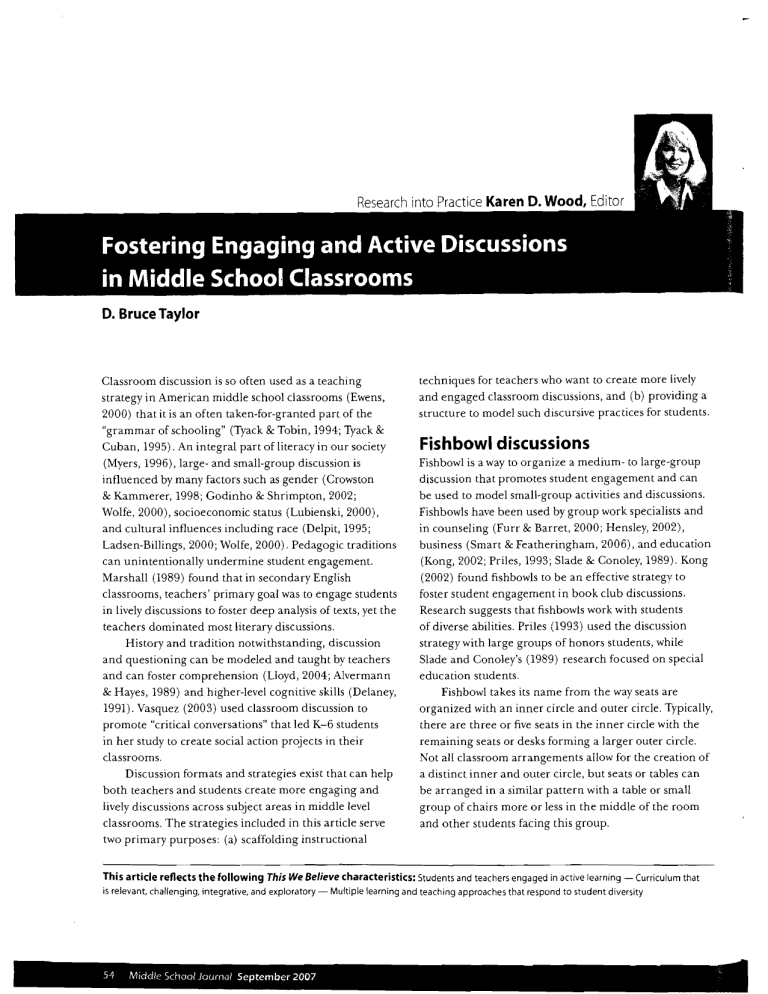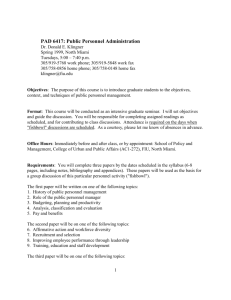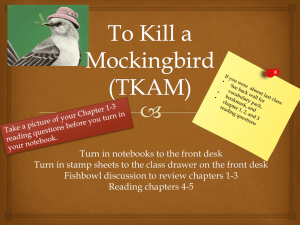
Research into Practice Karen D. Wood, Editor D. Bruce Taylor Classroom discussion is so often used as a teaching strategy in American middle school classrooms (Ewens, 2000) that it is an often taken-for-granted part of the "grammar of schooling" (Tyack & Tobin, 1994; Tyack & Cuban, 1995). An integral part of literacy in our society (Myers, 1996), large- and small-group discussion is influenced by many factors such as gender (Crowston & Kammerer, 1998; Godinho & Shrimpton, 2002; Wolfe, 2000), socioeconomic status (Lubienski, 2000), and cultural influences including race (Delpit, 1995; Ladsen-Billings, 2000; Wolfe, 2000). Pedagogic traditions can unintentionally undermine student engagement. Marshall (1989) found that in secondary English classrooms, teachers' primary goal was to engage students in lively discussions to foster deep analysis of texts, yet the teachers dominated most literary discussions. History and tradition notwithstanding, discussion and questioning can be modeled and taught by teachers and can foster comprehension (Lloyd, 2004; Alvermann & Hayes, 1989) and higher-level cognitive skills (Delaney, 1991). Vasquez (2003) used classroom discussion to promote "critical conversations" that led K-6 students in her study to create social action projects in their classrooms. Discussion formats and strategies exist that can help both teachers and students create more engaging and lively discussions across subject areas in middle level classrooms. The strategies included in this article serve two primary purposes: (a) scaffolding instructional techniques for teachers who want to create more lively and engaged classroom discussions, and (b) providing a structure to model such discursive practices for students. Fishbowl discussions Fishbowl is a way to organize a medium- to large-group discussion that promotes student engagement and can be used to model small-group activities and discussions. Fishbowls have been used by group work specialists and in counseling (Furr & Barret, 2000; Hensley, 2002), business (Smart & Featheringham, 2006), and education (Kong, 2002; Priles, 1993; Slade & Conoley, 1989). Kong (2002) found fishbowls to be an effective strategy to foster student engagement in book club discussions. Research suggests that fishbowls work with students of diverse abilities. Priles (1993) used the discussion strategy with large groups of honors students, while Slade and Conoley's (1989) research focused on special education students. Fishbowl takes its name from the way seats are organized with an inner circle and outer circle. Typically, there are three or five seats in the inner circle with the remaining seats or desks forming a larger outer circle. Not all classroom arrangements allow for the creation of a distinct inner and outer circle, but seats or tables can be arranged in a similar pattern with a table or small group of chairs more or less in the middle of the room and other students facing this group. This article reflects the following This We Believe characteristics: Students and teachers engaged in active learning - Curriculum that is relevant, challenging. integrative, and exploratory - 54 Middle School Journal September 2007 Multiple learning and teaching approaches that respond to student diversity Fishbowl discussions have multiple purposes. Fishbowls can be effective teaching tools for modeling group processes (Hensley, 2002; Priles, 1993), for engaging students or other groups in discussions of cross-cultural or challenging topics (Slade & Conoley, 1989), or for giving students greater autonomy in classroom discussions (Dutt, 1997; Gall & Gillett, 1980). thoughts and ideas rather than on the teacher's. Teachers can extend students' participation by allowing them to generate questions for the discussion. Students can bring these as "entry tickets" to the discussion or can work in small groups to generate questions collaboratively. Fishbowl is a flexible format that can also be used by teachers to model small-group discussion. Fishbowl as a student-centered discussion activity Fishbowl as a tool for modeling discussion The teacher arranges the room in a fishbowl, with inner and outer circles of students, and often assigns a text (section of a textbook or book, a poem, an article, or a video) to be read or viewed prior to the discussion. The teacher can generate a set of questions by writing them on slips of paper or index cards, or students can write questions or comments on cards. Four or five students sit in the inner fishbowl and begin a discussion using the questions; only these students can talk. If a student in the outer circle wants to say something, he or she must get up, tap one of the students in the inner circle on the shoulder, and take his or her place. Whenever a student is "tapped out" of the fishbowl, he or she takes a seat in the outer circle and cannot speak unless he or she returns to the inner fishbowl by tapping another student out. If students are reluctant to enter the fishbowl, the teacher can change the rules so that, after a few minutes, the inner group can tap others into the fishbowl. If students are too quick to jump into the fishbowl (that is, they do not give their peers a fair amount of time to talk before tapping them out), the teacher can set a time limit of one, two, or three minutes during which students cannot be tapped out. Middle school students are social and know how to talk with one another; however, teachers usually find small­ and large-group discussions about subject matter more challenging to facilitate. Fishbowl can be a vehicle for modeling and having a meta-discussion about discussion. As in the example above, the teacher and students arrange the room with an inner and outer circle. The teacher selects an appropriate text such as a poem, a short story, a brief article, or a few pages of a textbook or book and assigns students to read the selection in class or for homework. After all students have read the text on their own, the teacher selects three to five students for the fishbowl group to discuss the text. They can say or ask anything they want. The outer circle must remain quiet but can write down their observations about the discussion. After several minutes, the inner group stops, and the outer circle critiques the discussion or offers suggestions to the fishbowl group. The teacher can point out strengths of the discussion, offer helpful comments and questions, and make suggestions for ways to strengthen the discussion. This is a great way to model a discussion and talk about what makes for an effective small-group discussion. Fishbowl can be a vehicle for modeling and haVing a meta-discussion about discussion. This discussion format can be used in any subject area classroom in which student-centered discussion is desired. The author has used this format in primary and secondary English language arts, science, social studies, and mathematics classrooms on such topics as global warming, the Holocaust and World War II, and various novels and shon stories. It has also been effective in math classes for discussions of problem solving. Used this way, fishbowl discussions place the focus on students' Fishbowl discussions can be used to model discussions of challenging or controversial material in any subject area. For example, a biology teacher can use fishbowl at the outset of a unit on Evolution to help students establish generative and appropriate boundaries for their discussions about the topic. Similarly, a social studies teacher can use fishbowl as a way to begin discussions about issues such as slavery or segregation. Also, fishbowl is a great way to model literature circle Research mto PractlCe 55 or book club (Raphael & McMahon, 1994) discussions in an English language arts class. Fishbowl is a flexible and powerful tool that can help empower students in discussions across subject areas. The next strategy, ticket to talk, can be used in conjunction with fishbowl to increase student ownership of classroom discussions. Ticket to talk Ticket to talk is a discussion strategy involving admission or exit slips. Students create these slips by writing anonymous comments or questions about a text or topic at the end of a class period (an exit slip) or as homework with an assigned reading (an admission slip to the next day's class) (Fisher & Frey, 2004; Cere, 1985). Teachers can use these student-generated questions for whole­ class or small-group discussions or as writing prompts. The value of student-generated questions should not be underestimated. Their use can increase student participation and allow teachers greater access to students' levels of comprehension (O'Keefe, 1995). Ticket to talk can be an effective tool to generate questions for fishbowl discussions. Teachers assign a reading in or out of class and give students a ticket to talk slip as an admission slip to the fishbowl discussion. Used this way, the authors have seen lively discussions generated in a variety of middle level classrooms, including science, social studies, language arts, health, and family/consumer science. Discussion webs Discussion webs (Alvermann, 1992) encourage students to engage the text and each other in thoughtful discussion by creating a framework for students to explore texts and consider different sides of an issue in discussion before drawing conclusions (Wood & Taylor, 2005). Discussion webs are an alternative to teacher­ dominated discussions to help activate prior knowledge and make predictions about the text. This activity can also help students who are not comfortable participating in large-group discussions talk with a partner or in a small group. Discussion webs work well in various content areas. For instance, discussion web is an excellent format for considering differing views on global warming in a science class (Wood & Taylor, 2005). As we see in Figure 1, discussion web can also be used in an English/ language arts class. The group of sixth grade students in this class was discussing Bridge to Terebithia (Paterson, 1977) after their literature circle group finished reading the book. Students in a social studies class could use discussion web to consider reasons for and against the U.S. decision to drop atomic bombs on Hiroshima and Figure 1 Discussion web paired with discussion of Bridge to Terebithia Question Should Jess have gone back to Terebithia after the accident? Reasons He wanted to say goodbye to Leslie. He needed to face his fear. He was there to save May Belle. ~ ;7 Reasons It could have been dangerous. It wasn't the same without Leslie. He should have gone back when he found out May Belle followed him. He saw a sign (a bird) and it made him feel better. Conclusions Yes. Even though it was dangerous, going back to Terebithia helped Jess. 56 MiddlE' School Journal September 2007 Nagasaki at the end of World War II or in a math class to consider alternate ways to solve a multi-step problem. As with strategies such as fishbowl and ticket to talk, discussion webs help break the tradition of teacher­ centered and controlled discussion and create an opening for student engagement in conversations that foster higher-level thinking (O'Keefe, 1995). However, questions for discussion webs must be crafted carefully so that they are yes/no questions. Discussion web does not work with open-ended and nuanced questions but can create meaningful and lively discussions about substantive issues that arise in different subject area classrooms. Motivation is an important aspect of engagement, which, in turn, is itself an important prerequisite for learning and a factor in reading achievement and text comprehension (Guthrie, Wigfield, Metsala, & Cox, 1999). The strategies suggested above, such as fishbowl and discussion web, are powerful tools for motivating and engaging students in classroom discussions. However, there are times when students' struggles with challenging texts and material are more demanding, requiring teaching strategies that offer opportunities for modeling and scaffolding (Combs, 2004) of processes that promote comprehension, such as say something and QAR. Say something Say something (Short, Harste, & Burke, 1996) is a metacognitive discussion strategy that provides students with opportunities to increase comprehension and monitor their understanding of diverse and challenging texts. While the strategies suggested so far provide more open-ended opportunities for students to discuss texts and topics, say something is a more structured approach to discussion. Say something provides a set of discussion prompts for pairs of students to use in a text or topic­ centered conversation. These prompts work well with narrative and expository texts. Teachers assign students a partner and then assign a portion of a text that is read either silently or aloud. Students take turns reading parts of the text and, in turn, "say something" about what they have just read. This might involve summarizing the material, connecting with a character, or asking each other questions. Partners take turns reading and saying something until the text selection is complete. The rules or prompts for say something are these: Make a prediction. - Ask a question. Figure 2 QAR with a science textbook reading about forest fires "Right There" "Think and Search" "On My Own" + What are three common causes of forest fires? Why are more homes affected by forest fires (lightning strikes, volcanic eruptions, today than 50 or 100 years ago? (Increases on their own? (students can take a position and humans) in population, more homes built near forests, for or against this) Should forest fires be allowed to burn more fire suppression today than in the past) Research into Practice 57 Clarify something you had misunderstood. Make a comment. - Make a connection. When a student cannot do one of these five things, he or she needs to reread the text selection. Say something is a strategy that helps students who struggle with comprehension learn to have what Wolfe (1995) calls a conversation with the text. The range of questions embedded in say something provides learners with a metacognitive vocabulary for having that conversation, which is the hallmark of successful reading and learning. The final strategy, QAR, also helps scaffold discussions and foster comprehension but places emphasis on the kinds of questions we ask of texts. Question-answer relationships (QAR) Like its name suggests, question-answer relationships (Raphael, 1982; Raphael & Au, 2005) is a strategy that has students examine the relationship between a question and the kind of information needed to answer that question. QAR uses three or four categories of questions, such as (a) "right there" questions that can be answered directly from the text, (b) "think and search" questions that require students to combine their prior knowledge with information from the text to make inferences, and (c) "in my head" questions that students answer on their own. These categories cause students to indicate whether the information they used to answer questions about the text was textually explicit information (information that was directly stated in the text), textually implicit information (information that was implied in the text), or information entirely from the student's own background knowledge. This strategy works well with both fiction and nonfiction. Teachers and students can create questions that fall into one of the three categories. It is helpful for students to read the questions prior to reading the text and to make predictions about which category each question fits into. Teachers can model QAR using an overhead transparency and then transfer responsibility for using QAR to small groups, pairs, and then individual students. Figure 2 provides examples of the three kinds of questions asked of students during a unit on natural hazards in a science class. The first question, "What are three common causes of forest fires?", is an explicit question that requires students to go to a specific section of the textbook to answer it. Students must use information in the text to answer the second question, "Why are more homes affected by forest fires today than 50 or 100 years ago?", but they must also make inferences based on their knowledge of population increases over the last century. Students can take a stand on either side of the third question, "Should forest fires be allowed to burn on their own?" Their answer may be informed by what they have read, but it is essentially an opinion question. QAR can help foster a metacognitive conversation among students about what a question demands of them. It can provide a vocabulary or set of terms that can be useful when students struggle to answer a question during a discussion about a text. The teacher can ask students to consider what kind of question is being asked-a text implicit or explicit question. Finally, in an era of high-stakes accountability testing, QAR is a useful test-taking strategy for multiple choice test questions that follow reading passages. Conclusion A small group of students learns to apply the question-answer relationship strategy. P'wto'yAln" Geho 58 Middle School Journal September 2007 Strategies like fishbowl, discussion webs, and ticket to talk can help middle grades teachers motivate students to participate in active and comprehensive discussions • Kong, A. (2002, April). Scaffolding in a learning community ofpmctice: in several content areas. They work with students across ability levels and give more ownership of classroom discussion to students. Motivation and engagement are two key ingredients in fostering comprehension with diverse learners, but for students who may struggle with comprehension, we include QAR and say something. These two strategies provide metacognitive tools for students and provide teachers a way to model meaningful discussion. References Alvermann, D. E. (1992). The discussion web: A graphic aid for learning across the curriculum. The Reading Teacher, 45,92-99. Alvermann, D. E., & Haves, D. A. (1989). Classroom discussion of content area read'ing assignments: An intervention study. Reading Research Quarterly, 24, 305-335. Combs, D. (2004). A framework for scaffolding content area reading strategies. Middle SchoolJournal, 36(2), 13-20. Crowston, K., & Kammerer, E. (1998). Communicative style and gender differences in computer-mediated communications. In B. Ebo (Ed.), Cyberghetto or cybertopia? Race, class, and gender on the internet (pp. 185-203). Westport, CT: Praeger. Delaney, E. (1991). Applying geography in the classroom through structured discussions. Journal of Geography, 90, 129-133. Delpit, L. (1995). Other people'S children: Cultural conflict in the classroom. New York: The New Press. Dun, K. M. (1997). The fishbowl motivates students to participate. College Teaching, 45, 143-148. Ewens, W. (2000). Teaching using discussion. In R. Neff & M. Weimer (Eds.), Classroom communication: Collected readingsfor effective discussion and questioning (pp. 21-26). Madison, WI: Atwood Publishing. Fisher, D., & Frey, N. (2004). Improving adolescent literacy: Strategies at work. Upper Saddle River, NJ: Pearson Education. Furr, S. R., & Barret, B. (2000). Teaching group counseling skills: Problems and solutions. Counselor Education and Supervision, 40(2),94-104. Gall, M. D., & Gillett, M. (1980). The discussion method in classroom teaching. Theory into Practice, 19(2),98-103. Gere, A. R. (Ed.). (1985). Roots in the sawdust: Writing to learn across the diSCIplines. Urbana, lL: National Council of Teachers of English. Godinho, S., & Shrimp ton, B. (2002, December). Exploring differences in students' engagement in literature discussions. Paper presented at the Annual Meeting of the Australian Association for Research in Education, Brisbane, Australia. Guthrie,]. T, Wigfield, A., Metsala,]. L., & Cox, K. E. (1999). Motivational and cognitive predictors of text comprehension and reading amount. Scientific Studies ofReading, 3, 231-256. Hensley, L. G. (2002). Teaching group process and leadership: The two-way fishbowl model. .Journalfor Specialists in Group Work, 27, 273-286. :l. case study of a gradual release of responsibility from the teacher to the students. Paper presented at the Annual Meeting of the International Reading Association, San Francisco. Ladsen-Billings, G. (2000). Fighting for our lives. Journal of Teacher Education, 51(3), 206-214. Lloyd, S. L. (2004). Using comprehension strategies as a springboard for student talk. Journal of/ldolescent and Adult Literacy, 49(2), 114-124. Lubienski, S. T. (2000). A clash of social class cultures' Students' experiences in a discussion-intensive seventh-grade mathematics classroom. The Elementary SchoolJournal, 100, 377-403. Marshall,]. D. (1989). Patterns of discourse in classroom discussions of literature. Albany, NY: SUNY Albany, Center for the Learning and Teaching of Literature. Myers, M. (1996). Changing our minds: Negotiating English and literacy. Urbana, IL: National Council of Teachers of English. O'Keefe, V. (1995). Speaking to think/thinking to speak: The importance of talk in the learning process. Portsmouth, NH: Boynton/Cook Publishers. Paterson, K. (1977). Bridge to Terabithia. New York: Thomas Y. Crowell. Priles, M. A. (1993). The fishbowl discussion: A strategy for large honors classes. TheEnglishJournal, 82(6), 49-50. Raphael, T E. (1982). Question-answering strategies for children. Reading Teacher, 36, 186-191. Raphael, T E., & Au, K. H. (2005). QAR: Enhancing comprehension and test taking across grades and content areas. The Reading Teacher, 59, 206-22\. Raphael, T E., & McMahon, S. (1994). Book club: An alternative framework for reading instruction. Reading Teacher, 48, 102-116. Short, K. G., Harste,]., & Burke, C. (1996). Creatingclassroomsfor authors and inquirers (2nd ed.). Portsmouth, NH: Heinemann. Slade,]. C., & Conoley, C. W. (1989). Multicultural experiences for special educators. Teaching Exceptional Chzldren, 22(1),60-64. Smart, K. L., & Featheringham, R. (2006). Developing effective interpersonal communication and discussion skills. Business Communication Quarterly, 69(3),276-283. Tyack, D., & Cuban, L. (1995). Tinkering toward utopia. Cambridge, MA: Harvard University Press. Tyack, D., & Tobin, W. (1994). The "grammar" of schooling: Why has it been so hard to change? American Educational Research Journal, 31, 453-479. Vasquez, V. (2003). Getting beyond "!like the book": Creating space for cnticalliteracy in K-6 classrooms. Newark, DE: International Reading Association. Wolfe,]. (2000). Gender, ethnicity, and classroom discourse: Communication patterns of Hispanic and White students in networked classrooms. Written Communication, 17,491-519. Wolfe, D. P. (1995). Reading reconsidered: Literature and literacy In high school. New York: The College Board. Wood, K. D., & Taylor, D. B. (2005). Literacy strategies acroSs the subject areas (2nd ed.). New York: Allyn & Bacon. Karen D. Wood is a professor of reading education and graduate reading program coordinator at the University of North Carolina at Charlotte. E-mail: kdwood@emall.uncc.edu D. Bruce Taylor is an assistant professor of reading and elementary education at the University of North Carolina at Charlotte. E-mail: dbtaylor@uncc.edu Research into Practice 59


